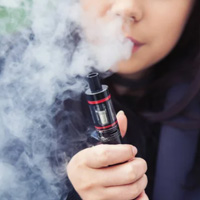 Vaping ‘epidemic’ among students has school brass on alert
Vaping ‘epidemic’ among students has school brass on alert
STORY BY REGINA MARCAZZO-SKARKA (Week of May 9, 2024)
More than 250 students have been suspended from county public schools since August for vaping nicotine, and another 225 students got caught but were diverted to an in-school prevention program to head-off repeat offenses.
That’s nearly four times the number of students disciplined for drug possession, and the majority of the 132 students caught with drugs used an electronic vape cartridge to inhale the psychoactive component of marijuana, THC.
The number of kids vaping is way too high, said School Board Chair Teri Barenborg, who recently spent time on high school campuses discussing the topic with students. “We need to do something about it,” she said. “They told me it’s an out-of-control epidemic.”
Adding to the problem is easy online vaping products like Elf Bars and Esco Bars being marketed to youth.
Last week, the FDA issued warning letters to 14 online retailers citing the sale of the products. Among the more than 2.1 million youths who reported current use of e-cigarettes, more than half said they used Elf Bar products and over 20 percent reported they used Esco Bar products.
Due to the highly addictive nature of E-Juice chemicals inhaled by vaping, curbing the vaping epidemic among teenagers is challenging local school officials and parents. Adding to the problem is that most kids don’t view vaping as harmful or potentially deadly.
Nearly half of Indian River County middle school students and more than half of high school students do not see any great risk in vaping nicotine or marijuana, and the percentages are increasing, according to the most recent surveys in 2022 conducted by the Florida Youth Substance Abuse Survey (FYSAS).
Independent data collected since 2020 indicates there’s a whole lot more student vaping taking place than the number of kids getting caught and disciplined at school would indicate.
Based upon that delusion that vaping is safe, 23.3 percent of the county’s high school students and 13.2 percent of middle school students admitted vaping nicotine at least once; while 18.5 percent of high schoolers and 7.6 percent of middle schoolers have vaped marijuana.
A 2020 survey about vaping asked students if they’d vaped in the past 30 days, and 9.9 percent of high school students said yes to nicotine, while 8.7 had vaped marijuana. Among middle schoolers, 4.8 percent had vaped nicotine, and 3 percent had vaped marijuana in the past month.
“Prevention is a primary focus for our organization because substance use disorders are a disease of adolescence; they start and are prevented in adolescence,” said Substance Aware Center of Indian River County Executive Director Carrie Maynard-Lester.
“The adolescent brain is still developing, making it much more vulnerable to the effects of substance use. In addition, youth are vaping high content nicotine and THC, which compounds the impacts of their substance use,” she said. “Vaping puts our youth at risk.”
During the current school year, 3,966 students in grades 5 through 8 completed the Substance Awareness Center’s Prevent Plus Wellness (PPW) program for vaping, and 3,594 students in grades 6 through 8 completed the PPW module on marijuana use. The program will continue next year.
The PPW program teaches youth the importance of avoiding substance use and encourages positive health behaviors such as physical activity, sports, eating a healthy breakfast, getting good sleep, and controlling stress.
Nemours Children’s Hospital in Orlando, as part of its community outreach and education, has participated in numerous forums on vaping around the state. At one such event in Orlando, Director of Pediatric Pulmonology Dr. Floyd Livingston talked about the E-juice in the vape cartridges and said in addition to the commercially available products, “Kids are mixing this stuff up in their bathtubs,” he said.
The goal of vaping is to get the chemicals aerosolized and into the lungs efficiently. Unfortunately, it causes something called “popcorn lung,” a condition first seen in workers in popcorn factories where flavorings were being added to popcorn.
“They impact these small airways and cause these small airways to become inflamed,” Livingston said, and the result is the patient can’t get oxygen into their bloodstream so they become hypoxic. “They can’t get carbon dioxide out of their lungs, so they become hypercapnic and that’s what puts them in the hospital, in the Critical Care Units. They get tubes down their throats and mechanical ventilation.”
Livingston said he’s seen patients as young as 14 with popcorn lung, and if the damage is serious enough, young people can die, or require a lung transplant. In 2023, e-cigarette exposure cases requiring medical attention increased 32 percent from the previous year, according to CDC data. “This impacts many more people than Covid,” Livingston said.
Legislative efforts to prohibit smoking and vaping near schools have thus far failed, with the most recent House Bill 1095 that would have imposed stiff penalties dying in committee on March 3. Locally, the school board adopted an anti-vaping proclamation, but the problem requires more than words.
Staff Writer Lisa Zahner contributed to this report.



